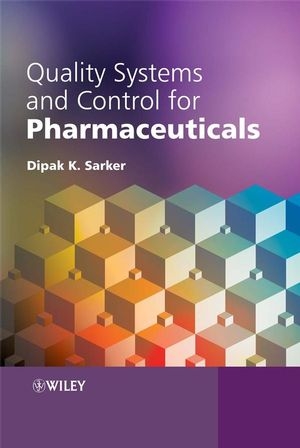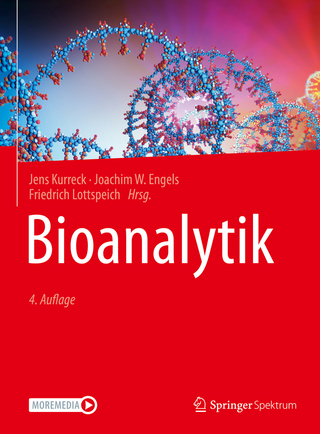
Quality Systems and Controls for Pharmaceuticals
Wiley-Blackwell (Verlag)
978-0-470-05692-9 (ISBN)
- Titel ist leider vergriffen;
keine Neuauflage - Artikel merken
Quality Systems and Control for Pharmaceuticals is an accessible overview of the highly-regulated area of pharmaceutical manufacture, the production of biomedical materials, and biomedical devices. Introducing the subject in a clear and logical manner it enables the reader to grasp the key concepts of the multidisciplinary area of control science and specifically quality control using industrial and theoretical models. Taking a multidisciplinary approach to the subject the reader is guided through key topics such as product safety which takes into account aspects of analytical science, statistics, microbiology, biotechnology, engineering, business practice and optimizing models, the law and safeguarding public health, innovation and inventiveness and contemporary best practice. The author has both industry and academic experience and many 'best practice' examples are included throughout the text based on his own industry experience and current practicing industrial pharmacists.
This is an invaluable reference for all students of pharmacy who may have little or no familiarity with industrial practice and for those studying BSc chemistry, biomedical sciences, process analytical chemistry and MSc in Industrial Practice.
Dipak Kumar Sarker is the author of Quality Systems and Controls for Pharmaceuticals, published by Wiley.
Preface xi List of figures xv List of tables xix Glossary of terms and acronyms xxi Glossary of mathematical and statistical symbols xxiii SECTION A Most Suitable Environment 1 1. Introduction 3 1.1 The process of finding new lead medicines 4 1.2 A drug discovery framework 6 2. Technology transfer and the climate of change 11 2.1 Innovation and research 11 2.2 Method transfer 14 3. Quality systems structure and a maximum quality environment 15 3.1 The quality gurus and models for assurance 18 3.2 A cycle of continual improvement 22 3.3 Management structure and a functioning department 22 SECTION B Setting Process Bounderies 29 4. Validation 31 4.1 Process and manufacturing validation activities 35 4.2 Valid analytical methodologies (VAMs) 43 5. Good manufacturing practices 57 5.1 Manufacture of standard products 60 5.2 Manufacture of materials requiring specialised production facilities 75 5.3 Quality assurance aspects of medical gases, devices and miscellaneous product manufacture 88 6. Process control via numerical means 97 6.1 Charting and quality inspection 99 6.2 Sampling plans 104 6.3 Measures of process compliance and variation 108 7. Product verification and the role of qualified personnel 111 7.1 Batch documentation 113 7.2 Standard operating procedures 114 7.3 Guides, overviews and validation plans 115 7.4 The duties of the qualified person 116 8. In-process and on-process QC testing and control 119 8.1 Process analytical technologies 120 8.2 Analytical validation and clinical test validation (CTV) 121 8.3 LIMS and automation 126 SECTION C Starting from Scratch 131 9. Applications of QA to new medicinal products and new chemical entities formulation 133 9.1 Start-up and initialisation 134 9.2 Raw materials control 134 9.3 The validation life cycle 134 9.4 Top-down or bottom-up validations 135 10. New products manufacturing 137 10.1 From inception to market place 139 10.2 New product development: product design and specification 146 11. Questions and problems 151 11.1 Specimen examples and exam questions 151 11.2 Model answers to examples 162 References 169 Index 177 Preface xi List of figures xv List of tables xix Glossary of terms and acronyms xxi Glossary of mathematical and statistical symbols xxiii SECTION A Most Suitable Environment 1 1. Introduction 3 1.1 The process of finding new lead medicines 4 1.2 A drug discovery framework 6 2. Technology transfer and the climate of change 11 2.1 Innovation and research 11 2.2 Method transfer 14 3. Quality systems structure and a maximum quality environment 15 3.1 The quality gurus and models for assurance 18 3.2 A cycle of continual improvement 22 3.3 Management structure and a functioning department 22 SECTION B Setting Process Bounderies 29 4. Validation 31 4.1 Process and manufacturing validation activities 35 4.2 Valid analytical methodologies (VAMs) 43 5. Good manufacturing practices 57 5.1 Manufacture of standard products 60 5.2 Manufacture of materials requiring specialised production facilities 75 5.3 Quality assurance aspects of medical gases, devices and miscellaneous product manufacture 88 6. Process control via numerical means 97 6.1 Charting and quality inspection 99 6.2 Sampling plans 104 6.3 Measures of process compliance and variation 108 7. Product verification and the role of qualified personnel 111 7.1 Batch documentation 113 7.2 Standard operating procedures 114 7.3 Guides, overviews and validation plans 115 7.4 The duties of the qualified person 116 8. In-process and on-process QC testing and control 119 8.1 Process analytical technologies 120 8.2 Analytical validation and clinical test validation (CTV) 121 8.3 LIMS and automation 126 SECTION C Starting from Scratch 131 9. Applications of QA to new medicinal products and new chemical entities formulation 133 9.1 Start-up and initialisation 134 9.2 Raw materials control 134 9.3 The validation life cycle 134 9.4 Top-down or bottom-up validations 135 10. New products manufacturing 137 10.1 From inception to market place 139 10.2 New product development: product design and specification 146 11. Questions and problems 151 11.1 Specimen examples and exam questions 151 11.2 Model answers to examples 162 References 169 Index 177
| Verlagsort | Hoboken |
|---|---|
| Sprache | englisch |
| Maße | 171 x 257 mm |
| Gewicht | 498 g |
| Themenwelt | Medizin / Pharmazie ► Medizinische Fachgebiete |
| Naturwissenschaften ► Biologie ► Mikrobiologie / Immunologie | |
| Naturwissenschaften ► Chemie | |
| Technik | |
| ISBN-10 | 0-470-05692-4 / 0470056924 |
| ISBN-13 | 978-0-470-05692-9 / 9780470056929 |
| Zustand | Neuware |
| Haben Sie eine Frage zum Produkt? |
aus dem Bereich


